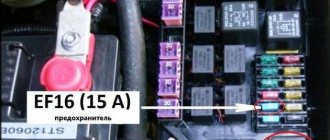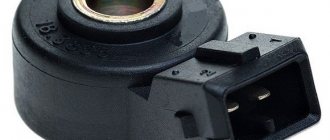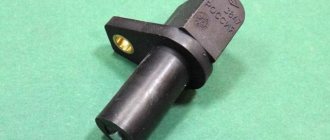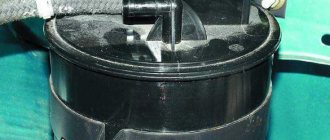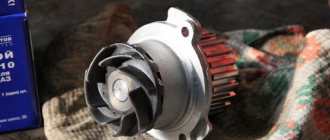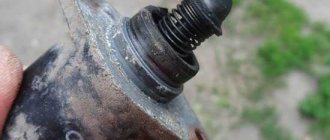The water pump (water pump) of the engine cooling system is an important component that ensures constant circulation of coolant through the channels of the cooling jacket, pipes, lines, cooling radiator, etc. Even a slight decrease in the performance of a car pump can cause the engine to overheat, especially in the warm season.
We also recommend reading the article about the design of the cooling system water pump. From this article you will learn about the operating principles and design features of the pump.
Another reason to check whether the pump is working or not is possible extraneous noise in the water pump drive. In this case, the specified pump requires increased attention on some car models. The fact is that the pump can be driven by the timing belt. If the water pump jams, then the timing belt breaks, resulting in valve bending on most engines. Next, we will look at the available methods that allow you to check the water pump yourself.
Symptoms of malfunction
- Noise from the pump when the engine is running. Extraneous sound appears due to bearing wear. It is recommended to replace the cooling system pump after one or every replacement of the timing belt kit. If you neglect service intervals, wear appears on the rolling elements, inner and outer races, which leads to noise and whistling. Often the cause of accelerated wear is antifreeze, which, due to a leak in the oil seal or rubber cuff, gets to the rubbing vapors.
- Antifreeze leak. Like the pump bearing, the oil seal and rubber seal have a limited service life. The appearance of play due to bearing wear will significantly increase the risk of seal leakage.
- Misalignment with respect to timing gears and rollers (the pump becomes askew). Uneven tension distribution leads to accelerated wear of not only the bearing, but also the oil seal. Incorrect installation or a manufacturing defect, in which the pulley rotates misaligned, leads to accelerated wear of the loaded part of the belt. Such a defect, even with low mileage, can cause the timing belt to break and the valves to meet the pistons.
- Engine overheating. When the impeller blades break off, the pump's performance decreases, as a result of which less coolant passes through the small circulation circuit.
Often a decrease in performance is noticed after using a sealant to repair a radiator leak. The poured mixture clogs the cooling system channels and sticks to the pump impeller.
If the liquid has not clogged the coolant drain channel in the housing, then pouring sealant will not lead to a malfunction of the water pump. But you can’t do without removing the pump and flushing the system.
Signs that indicate the need to replace a part
Experts believe that the main factors that indicate a faulty water pump are:
- coolant leaking from the housing in the oil seal area;
- wear of the built-in bearing, which is determined by increased noise, humming during operation, or jamming;
- insufficient circulation of the coolant used;
- excessive increase in the temperature of the power unit;
- reducing the level of coolant poured into the system;
- the presence of cracks, chips, chipping of the material of the pulley, housing or impeller of the water pump.
The water pump, as a rule, is a non-repairable component due to its design. Therefore, experts recommend a complete replacement of this important part.
How to check the cooling system pump?
By checking the pump without removing it from the engine, we can only indirectly assess its performance. When the volume of pumped coolant decreases, the stove begins to heat poorly. But before removing the water pump to inspect the impeller, we recommend checking the thermostat and also making sure that there is no air lock in the cooling system.
After removal, pay attention not only to the integrity of the blades and where the impeller fits on the drive shaft, but also to the shape of the blades. For example, on the VAZ 2121 over many years of production, impellers were installed that differed in the diameter of the pump wheel, the number and profile of the blades. Installing a less efficient pump on a more heat-loaded engine modification will result in the cooling system fan turning on more frequently and an increased risk of overheating.
Be sure to inspect the engine block where the housing fits and the pump itself. Fogging or a slight leak of coolant from the drain hole does not mean that the pump should be replaced. If a significant leak is detected, try to pinpoint the location of the leak. If the leak is only at the junction of the housing and the engine block, most likely the problem can be eliminated without replacing the pump. It will be enough to apply sealant and install a new gasket.
Risk of timing belt breakage
The danger with a misaligned water pump timing belt is that there are no obvious signs of failure. First of all, you need to pay attention to the timing belt. If it is pulled to any side, uneven production is observed, it is necessary to check the pump and rollers. The cause of the misalignment may be a manufacturing defect, bearing wear, or uneven fit of the housing to the engine block (dirty, rusty mating planes). Sometimes the malfunction begins to manifest itself after an accident, when elements of the body or attachments hit the pump pulley.
Which pump for Lada Priora is better for 8 and 16 valves tips
The pump is the most important element of any car, including Prioras. It ensures coolant circulation, thereby avoiding overheating of the machine. However, a number of problems can arise with the part. However, it cannot be repaired; if it fails, it will have to be replaced. However, every car enthusiast wants to install products from a good manufacturer on their car. Today we’ll talk about why a pump can break, how to choose one for a Priora and which one is better.
Element malfunctions
The pump consists of several elements that ensure its operation. In particular:
- impeller;
- bearing;
- frame.
You can determine the malfunction of a part by ear
Pay attention to noise from the timing belt. If you hear a roar, then the reason may lie in this element
In addition, when the pump fails, the cooling of the car sometimes worsens, which automatically leads to increased overheating. Let's look at the main list of breakdowns that can plague the pump:
- Autonomous rotation of the impeller.
- The appearance of backlash.
- Bearing wedge.
- Element leakage.
In addition, it is recommended to replace the part after reaching certain mileage indicators. The standard is 100,000 kilometers. However, low-quality parts can hardly withstand 10,000 - 15,000 kilometers, so it is not recommended to save too much on the pump. Next, we’ll talk about which manufacturers’ products are worthy of attention.
Who to pay attention to
As a standard, VAZ cars are equipped with a pump manufactured by TZA. It is relatively good and can last quite a long time, but not all users are satisfied with its quality. An alternative solution could be Luzar. A trusted manufacturer that supplies pumps that are ideal for AvtoVAZ products. If you need a pump for a long time, Luzar may be a good solution.
If you prefer devices from foreign companies, it’s time to stop at SKF. A good option, characterized by an excellent price-quality ratio
Please note that you should not buy HEPU products. Its pulley is simply not suitable for Priora cars
A cheap but short-lived option would be Coram. This is a Chinese company that supplies inexpensive but very mediocre pumps.
A car water pump (or in other words, a pump) plays an important role in the normal operation of a car engine. Thanks to this device, coolant circulates through the channels of the cooling system without delay and reduces the temperature of all heated components of the power unit. A malfunction of the water pump can lead to unwanted overheating of engine parts and even completely render it inoperable. To avoid such an outcome, you must carefully monitor the condition of the pump.
An auto water pump (VP) or pump is structurally included in the liquid cooling system (LCS) of a modern car and is its key element. The main function of this part is to ensure intensive circulation of coolant (coolant) through the engine's fluid circulation system.
Thanks to this constant movement, the temperature of the liquid decreases and its ability to cool other parts and systems of the car is restored. As a rule, the water pump on a car engine is structurally located in front of the cylinder block. Its drive is carried out from the crankshaft through a special wedge-shaped belt or from the gas distribution mechanism (timing) using a toothed belt.
A special toothed belt ensures the functioning of the car's water pump.
General pump structure
The pump design consists of several elements, one of which is the obligatory gasket
The main components of an engine water pump are:
- product body;
- a shaft with an impeller and a special self-regulating oil seal, thanks to which the coolant is securely retained in the structure during operation;
- pump shaft bearing on which the pump shaft is mounted;
- drive pulley;
- radiator fan (this part can be attached to the pump drive or in a separate electric drive version, without any connection with the car’s water pump);
- gasket made of cardboard or special material.
Operating principle of the device
The operation of the coolant pump is as follows:
- with the engine running, the coolant that has cooled in the car radiator moves to the pump (in particular, to its impeller);
- the gaps between its blades are completely filled with coolant;
- due to the action of centrifugal force, the coolant is thrown by the impeller into different directions of the internal cavity of the HV;
- through the technological hole, the liquid goes into the channels of the cooling jacket of the motor elements;
- constant circulation of the cooling medium in the liquid cooling system is ensured.
Design Features
To prevent possible leakage, the pump body is installed on the engine cylinder block through a special gasket (for example, made of cardboard). The cooling fan, which is sometimes structurally located on the car pump pulley and driven simultaneously with it, is usually made of metal or durable plastic. To reduce operating noise, the blades of the structure are located at certain angles, in an X-shaped position, which corresponds to 110/70 degrees.
In order to reduce the power required to drive the fan, designers use a special electromagnetic clutch. This device can turn off the fan when the coolant temperature drops to a level of 78–85 degrees Celsius. In this way, the operation of the engine cooling system is optimized, and the noise level during operation of the unit is also reduced.
Required Tools
- open-end wrenches No. o10, No. o15, No. o17;
- spanners No. o15, No. o17;
- Allen key No. o5;
- two screwdrivers of different sizes;
- a specially designed wrench for installing the tension roller or a puller for retaining rings;
- Torx T-30 wrench used to remove the five screws that secure the front upper timing cover;
- mounting blade.
When installing the timing belt, it is necessary to tension it using a similar tool. To dismantle the water pump, a minimum set of tools is required. Thanks to this device, it is very convenient to fix camshafts, which are quite fragile products
The procedure consists of performing the following operations:
- The wire is disconnected from the negative terminal of the battery.
When starting work, the negative terminal of the battery is disconnected
The coolant used must be drained from the cooling system.
The adsorber and underwater hoses are dismantled to gain better access to the water pump
It is necessary to dismantle the engine protective casing
The part is removed to gain access to the water pump
Aligning the timing belt to the marks is necessary for proper engine operation after installing all dismantled parts
Parts are removed using a special tool to gain access to the water pump
When working, you can use a screwdriver
Mounting location of the water pump on the engine
Assembly is carried out in reverse order.
The new pump must be sufficiently lubricated with a special lubricant. During installation, it is recommended to apply a sealant to the new gasket, which will provide the device with the necessary reliability during operation.
Installation of the water pump is as follows:
- The tightening of the screw that locks the bearing installed in the VN housing is checked.
- The screw is tightened if necessary.
- The new pump is installed so that the product number is at the top.
The pump is installed in its place
Timing mechanism set by marks
The belt is tensioned using a tension roller using a special wrench.
The drive belt is installed in its place
Pump design
Let's look at the water pump up close!
- This device is located in a housing made of aluminum, inside which a roller rotates in a double-row bearing, the lubricant of which is sufficient for the entire period of operation of the pump. The outer ring of the bearing is locked with a screw.
- The toothed pulley is pressed into the front of the roller, and the impeller is pressed onto the reverse side. The impeller is also secured with a retaining ring made of graphite-containing materials.
- Such a one-piece design of the device will not allow repairs. And when a pump malfunction is detected (play, etc.) - only replacement.
Car behavior with a faulty pump
When the pump is faulty or its operation occurs with some difficulties in the operation of the engine, changes may also be observed:
- Poor circulation of coolant, as a result of which the car heats up faster and cools slower.
- The coolant level drops.
- Bearing noise in the engine compartment.
Signs of a fake pump. This is clearly not the famous Gates
Pump performance test
In order to make sure that the pump is fully operational, you can perform one very simple test. To do this, you need to warm up the engine to operating temperature, and then touch the upper radiator pipe. So, if the liquid circulates properly in the system, you will feel it with fairly intense movements inside.
Steam is coming from the radiator
When you notice steam coming from under the hood of your car, stop immediately - this is a sign of engine overheating. As mentioned above, the engine maintains a constant temperature when the water pump works smoothly and fluid circulates evenly through the radiator. When the temperature rises sharply, the liquid turns into steam, which comes out of the valve of the expansion tank or radiator. In this case, you cannot move the car and it is better to call a tow truck. This will save money in the short and long term and will cost less than replacing the entire engine.
The cooling system is designed to prevent overheating of the power unit. In this case, it is the pump that is responsible for the quality of operation of the entire system. It is located and attached differently on different car models, but the driver must know the basic methods of diagnosing, repairing and replacing the part in order to quickly restore the operation of the cooling system if necessary.
Reasons for pump failure on a VAZ-2112
The main signs of a pump malfunction are as follows:
The main reason for pump failure is play on the drive pulley of the entire structure, because of this the pulley begins to simply dangle . This directly indicates wear of the internal bearings and rapid failure of the entire pump as a whole. Such a defect is very easy to detect by touch, and with the timing belt removed, turn the pump pulley by hand and swing it in one direction or the other. If there is play on the pump, you will feel it immediately.
Main reasons
Before talking about the signs of a dying pump that needs replacement or repair, you need to say a few words regarding the reasons for the failure of this device.
In total, there are several main factors that cause this to happen:
- Using low quality antifreeze. About 90% of pumps break down precisely because of this. Such a cooling liquid contributes to the appearance of tarry deposits, which makes the impeller difficult to rotate;
- Corrosion. Again due to low-grade antifreeze;
- Cavitation, that is, the formation of vacuum bubbles that can literally tear out pump particles and destroy the mechanism;
- The result of normal wear and tear. Each device has a limited resource. The best samples last about 200 thousand kilometers;
- Broken fastening. It's simple. The fasteners became loose, the pump became loose and fell apart.
In most cases, it is the car owner himself who is to blame. Drivers are required to monitor the condition of the cooling system, periodically check the pump, and change the coolant on time.
We cannot exclude the problem of manufacturing defects, as well as simply low-quality and cheap pumps that are installed on budget cars or as part of repairs, thereby deceiving the client.
It is not surprising that the timing belt may then fail, the tension roller may rupture, the cylinder head gasket may break through, and other troubles that can cost a lot of money during repairs.
Problems with the water pump can occur on various cars:
- on Kalina;
- VAZ 2110;
- Lada Priora 16 valves;
- VAZ 2114;
- Lada Priora 8 valves;
- VAZ 2115;
- Daewoo Lanos;
- Niva Chevrolet;
- Daewoo Nexia;
- Lada Granta;
- Renault Logan;
- Chevrolet Aveo, etc.
Don’t think that this is a problem exclusively with cheap and budget cars, as well as simple engines like ZMZ 406.
The pump can also be used on more expensive cars. It all depends on how the owner monitors and maintains the car with his own hands, or in a car service center.
conclusions
In order to verify for yourself that the old pump is worn out and how it differs from the new one, simply take the old and new element and rotate the impeller on them in turn.
Comparison of the operation of the old and new pump. Check for play and ease of rotation.
You can clearly see from your example that on the old element its rotation will occur with interference, while on the new element it will not be necessary to exert excessive effort.
The car engine cooling system pump (water pump) is an important element that prevents overheating of the power unit. The operation of the internal combustion engine is accompanied by significant heating, therefore, to protect against overheating, forced circulation of antifreeze in the system is necessary. A pump failure can cause the coolant to boil and cause engine failure. Today you will learn how to check the condition of the pump without removing the element from the engine, and what to do if a malfunction is detected.
Should I change antifreeze after replacing the pump?
A question for those who want to save money everywhere and on everything. If I answer this briefly, I can confidently say that yes, the coolant needs to be changed. Please also pay attention to the question regarding mixing antifreeze in the cooling system. It will be useful and important to know all the nuances.
If we talk about the necessity of replacement, then everything is extremely simple. To begin with, in the vast majority of cases it is impossible to replace and remove the pump without first draining the antifreeze from the system. But some people want to save money; they drain the coolant into a clean container, install a new pump, and then pour the old antifreeze back in.
A big mistake, since any water pumps for cooling systems are characterized by increased demands on the quality and purity of the liquid. Therefore, you should absolutely not use previously drained antifreeze, even if you just recently changed it, even before the pump failed. Do not attempt to filter or strain the coolant. Just buy a new can of quality antifreeze that is suitable for your car and fill it up. There simply cannot be any other options. Remember this. Otherwise, you will soon have to spend money on a new pump again.
To ensure that the water pump lasts as long and reliably as possible, make it a rule to use only high-quality compounds. As you remember, 90% of pump failures are related precisely to the quality of the coolant used. I think it will not be difficult to draw the appropriate conclusions.
Have you encountered a water pump failure and how early were you able to identify the presence of malfunctions?
Thanks to everyone who reads us! Don't forget to leave comments, ask questions and invite your friends to join us!
(
1 ratings, average: 5.00 out of 5)
Did you like the article?
Subscribe to updates and receive articles by email!
We guarantee: no spam, only new articles once a week!
Pump design
The pump body is made of steel or aluminum, and inside it there is a shaft with a pulley on which the impeller is located. Also inside the pump you can see channels for supplying and discharging coolant. The rotation of the impeller ensures optimal fluid circulation in the system.
Have you already read our article about how different colors of antifreeze differ and whether they can be mixed? The information is quite interesting - https://avtopub.com/antifrizyi-raznyih-tsvetov/
Many cars have pumps whose impellers and casings are made of alloys of various metals, but there are also impellers made of plastic. You can find the pump at the front of the engine.
Rust, deposits
Symptoms of failure of the VAZ-2110, 2114 or other car models may be different. Upon external inspection of the pump, rust is visible. The most common corrosion is on the impeller blades. This leads to a decrease in the rate of pumping antifreeze into the system. The cause of rust may be contaminated coolant or a compound that is incompatible with the pump. Mixing different antifreezes can also lead to this problem.
Another cause of rust on the pump is damage to the pump cover. In this case, it will not be able to close hermetically. Due to this, air bubbles appear in the composition, which causes oxidation processes.
In this case, the pump will need to be replaced. The cooling system must be thoroughly flushed and new antifreeze added. It is necessary to check the tightness of the cap. You may need to replace it.
The pump should also be replaced if deposits have formed on the inside of the pump. Such signs of a malfunction of a pump 2114, 2110 or another model can only be determined by visual inspection of the system. Deposits of resin, minerals or other substances appear on the internal surfaces of the pump. They clog the pump, preventing the system from working properly.
The cause of this malfunction is contaminated antifreeze or the use of the wrong composition. The system must be thoroughly rinsed with special mixtures. The pump has been replaced and new high-quality antifreeze is added.
Checking the condition of the water pump
Checking the pump on a car is not that difficult. First, you need to warm up the engine so that it reaches operating temperature. After this, follow these steps:
- Pinch the upper pipe at the radiator outlet with your hand. When the pump is working, you will feel the pressure it creates. Be careful during this task as coolant temperatures are typically 90°C or more. If the antifreeze in the system does not pulsate or the pulsation is barely felt, perform a more detailed check.
- It is necessary to remove the timing mechanism protection and inspect the pump visually. Sometimes coolant leaks, which can be caused by a damaged seal, are immediately visible. In addition, signs of pump malfunction may include grayish or red-colored deposits in the area where it is located. In this case, the part will have to be removed.
- If you hear the characteristic sound of a faulty bearing while the motor is running, you need to check the pump for play in the shaft area. Just rock the pump drive gear. Sometimes everything is “cured” by simply replacing the bearing.
Installation instructions for an additional electric pump
Step-by-step instructions for installing this additional component are as follows:
- Provide access to the heater pipes under the hood of the car by removing components that interfere with operation.
- Compress one of the rubber pipes that comes out of the heater (stove), which is done to prevent coolant from leaking out, or drain antifreeze (antifreeze) from the entire system.
- Cut part of this pipe to the length of the corresponding pump being installed.
- The length of the fittings is not taken into account due to the fact that they fit into the pipes.
- It is necessary to select the diameter of the fittings on the electric pump in advance to obtain a high-quality connection.
- Secure the rubber pipes to the pump fittings using metal clamps.
- Attach the additional electric pump to a pre-selected location under the hood of the car (indicated above) using special fasteners.
An additional electric pump can be mounted in any place convenient for installation.
Video: step-by-step instructions for installing an additional electric water pump on a car
It is recommended to install such a pump only after a thorough check of the functionality of the entire cooling system of the car, since there are often faults in the stove, thermostat, and other components, which ultimately does not allow sufficient heating of the interior.
Life time
The cooling system pump is a consumable item. Some automakers recommend changing it every 4 years or 60,000 km (whichever comes first). But reviews and practice indicate that pumps from well-known manufacturers operate properly for approximately 100,000 km. That is why many drivers are accustomed to changing the pump simultaneously with every second timing belt replacement. That is, every 100-120 thousand km (a high-quality pump can be used as much as two timing belts).
The service life of the pump directly depends on what kind of liquid is poured into the cooling system. If you are used to driving on water or cheap antifreeze/antifreeze, this can speed up the wear process of the pump.
Fluid leaking from the drain hole or from under the seating surface
There may be various symptoms of pump failure for VAZ-2109, 2107, 2114 and other car models. So if the coolant was of poor quality, there may be a leak in the drain hole area. In this case, leakage occurs, the formation of drops after the car is broken in. This can be determined by looking at the surface of the drain hole. Please note that a small leak in a new pump is normal. This happens during the first 10 minutes of engine operation. This is because the mechanical seal moves to the correct position.
If a new pump has a break-in period. If the pump is not operating properly but fluid continues to flow from the drain port, the pump is damaged. It is necessary to thoroughly flush the cooling system and install a new pump. Then you need to fill in the required amount of new antifreeze of acceptable quality.
If there is leakage from under the seating surface, this also indicates a malfunction. In this case, a sign of failure of the VAZ-2107, 2110, 2109 or other models is humidity, the appearance of drops, drops on the body or around a certain area. The cause of such a breakdown is incorrect installation of the pump or incorrect use of sealants and gaskets.
If the pump is new, remove it and check that it is installed correctly. It is especially important to pay attention to the tightening torques. If the pump is already old, it needs to be replaced.
Is there any point in renovation?
Of course, almost any spare part can be repaired, but the question is the feasibility of this idea. We do not recommend repairing the pump, since its cost is not exorbitant. In addition, it is extremely undesirable to restore the pump on cars in which the pump is connected to the timing belt. Otherwise, you risk a very serious risk, since a jammed pump can lead to a broken belt. And this is already fraught with dire consequences for the engine, requiring significant investments.
Cavitation, bearing damage
When considering the symptoms of a motor pump failure, you should pay attention to such a negative phenomenon as cavitation. This is the process of formation of air bubbles in antifreeze. They damage the internal surfaces and individual parts of the pump. As a result, scratches remain on them. Then they rust.
Air bubbles appear in the pump inlet. When the pressure in the system increases, they are destroyed. This process causes significant system damage and can cause engine failure. Therefore, it is better not to save money and buy a new pump. It will be much more reliable than a refurbished pump.
It is very important to install it correctly in its original place. Particular attention is paid to seals and proper tightening of fasteners. In some cases, a special sealant is used for joints. Eliminates leakage. However, it is not always possible to use the presented material. This will prevent you from later loosening the engine mounts to secure the timing belt on some car models.
If you know the signs of a bad pump, you can replace it on time. First you need to remove the cover from the timing belt. If necessary, the tensioner will need to be loosened and removed. Then reduce the mounting force on the generator. Its belts and timing belt have been removed. The hose from the pump can be disconnected. Then the antifreeze is drained. After this, you can remove the protective cover and pump.
After installing the new pump in place, align the alignment marks. This is necessary because the crankshaft can move relative to the camshaft.
Which pump to choose? Famous manufacturers
The best choice is original products. This is a guarantee that the part will fit the car exactly and will withstand the declared service life. The high cost of such spare parts is usually quite justified.
If you choose from substitutes, buyers often prefer water pumps from European brands:
- SKF;
- Hepu;
- Saleri Sil;
- Valeo.
These parts are made of high-quality metals, they are equipped with impellers and bearings with a long service life. The cost is high, but you don’t have to worry about quality.
You can also take a closer look at the German manufacturer Ruville and the Italian companies Graf and Dolz. Water pumps from the manufacturers Profit, JP Group and Thermotec are also considered normal, but these options are best chosen if you have a limited budget.
If the water pump fails before the time stated by the manufacturer, the reason is a manufacturing defect or the purchase of a fake. We recommend choosing Ruville, Valeo and SKF products.
How to determine if your pump is faulty
Checking your car's engine water pump for faults is quite simple. The simplest method is to try by touch to see if there is any play or no play on the pump shaft. To do this, just grab the pump shaft with your fingers and pull it from side to side in a direction perpendicular to the shaft itself (that is, across). If the bearing is in order, then there should be no play. If even a slight play occurs, then the pump needs to be replaced.
However, a more thorough check without removing the pump is performed using the following algorithm:
- Warm up the engine to operating temperature. That is, so that the coolant temperature is around +90°C.
- With the engine running, hand pinch the thick coolant pipe that comes from the radiator.
- If the pump is working properly, then pressure should be felt in it. If there is no pressure or it is pulsating, then this means that the pump is partially or completely out of order. Most likely the pump impeller has turned.
Also, to check the pump, you need to visually inspect its seat. To do this, you need to dismantle the protective casing of the gas distribution mechanism in order to gain access directly to the pump (the design is different for different cars, so perhaps there will be no casing or it does not need to be removed). Next, carefully inspect the pump body, its seal and seat.
Replacing the pump
After checking the water pump, repairing it, or purchasing a new element, all that remains is to install it in place. We advise you to pay maximum attention to the moment of installing the gasket and tightening the fastening bolts. Some experts advise using sealants to provide reliable protection against leaks. Sometimes this is not possible because on some vehicles the sealant will prevent the pump from being loosened in the future to replace the timing belt.
In some cases, car owners decide to replace the coolant and flush the system at the same time as replacing the pump. Instructions for performing washing were published on our website earlier - https://avtopub.com/kak-promyit-sistemu-ohlazhdeniya-dvigatelya-samostoyatelno/
In addition, follow the manufacturer's recommendations regarding bolt tightening torque (this information is in the service manual). Otherwise, you may pinch the gasket or damage the threaded connection. Finally, you need to fill in the coolant.
Important! If you used a sealant, wait a few hours for it to dry.
In the process of adding antifreeze or antifreeze to the cooling system, it is necessary to get rid of air pockets. After installing a new or restored pump and warming up the power unit, be sure to inspect the installation site for coolant leaks.
Factory service life of the pump
The service life of a water pump depends on the supplier of the product or, in other words, on the build quality of the pump, the elements and materials used. A not quite high-quality pump can fail even after 10 thousand kilometers of the car. The service life of a good part can be 100 thousand kilometers without any signs of failure of the part.
Experts recommend installing an original water pump on the car from the manufacturer TZA (Tolyatti Automotive Unit Plant), which has good quality and a significant period of trouble-free operation.
There are some requirements that must be met to obtain a high-quality result after installing an additional electric pump.
These include the following points:
- the installed product should not create excess pressure in the heater radiator during operation in order to avoid damage to the pipes or the formation of cracks;
- It makes sense to replace the thermostat and install this component with an increased opening temperature (90–95 degrees Celsius) due to the fact that as the speed in the coolant circulation increases, the engine parts will warm up more slowly, increasing wear on the power unit.
To solve this problem, you can install an additional water pump in the cooling system of the power unit, which will qualitatively improve the heating of the car interior even when the engine is idling. This technology is not new. Engineers have been using it for a long time. Examples include German cars BMW or Mercedes Benz.
Device selection
These, for example, could be brands from:
The design of the new pump version is much more successful and causes fewer complaints from car enthusiasts. And it is also less noisy during operation. The main problem that motorists encounter when using such an electric pump is its leakage.
Installation and connection of an additional electric pump
To equip a car with an additional electric water pump, you will also need a regular relay that has normally open contacts (this can be an ignition or starter relay from a VAZ 2105, VAZ 2108). It is necessary to close contacts No. o86 and No. o30. And you will also need a reinforced hose and clamps for clamping the pipes.
An additional pump can be installed in any of the gaps in the supply or outlet pipes of the car’s heating stove.
Installation of an additional electric pump is quite simple, and the efficiency of the heater increases significantly
- stud for fastening the washer reservoir;
- studs located next to the battery;
- on the engine shield.
The device can be connected to a wide variety of systems.
- recirculation button;
- SAUO stove block;
- heated mirrors;
- other convenient places.
Other verification methods
First you need to remove the plastic cover and the timing belt cover. To remove the upper parts that separate the pulleys from the cylinder block, follow these steps in sequence. This is only possible after removing the camshaft timing belt and pulleys (sprockets and support pulley). Only after this can the pump be disassembled.
To gain access to the bottom cover mounting bolts, remove the right wheel. The pump can then be disassembled. Then follow the same steps as in the previous step. If the pump is installed incorrectly, it will leak. Therefore, it is important to follow the manufacturer's instructions.
Malfunctions in the operation of the pump occur, significant play on its shaft, failure of the seal, wear of the impeller (corrosion or cracking). All these shortcomings lead to the fact that the water pump in the car does not work properly, due to which the engine cooling system does not maintain the required pressure, which in turn leads to an increase in the temperature of the coolant to the boiling point. . You need to buy a new pump and install it in place of the old one.
There are only six main symptoms of a “dying” pump, by which we can say that the pump has partially (or even completely) failed and requires replacement. So, these symptoms include:

